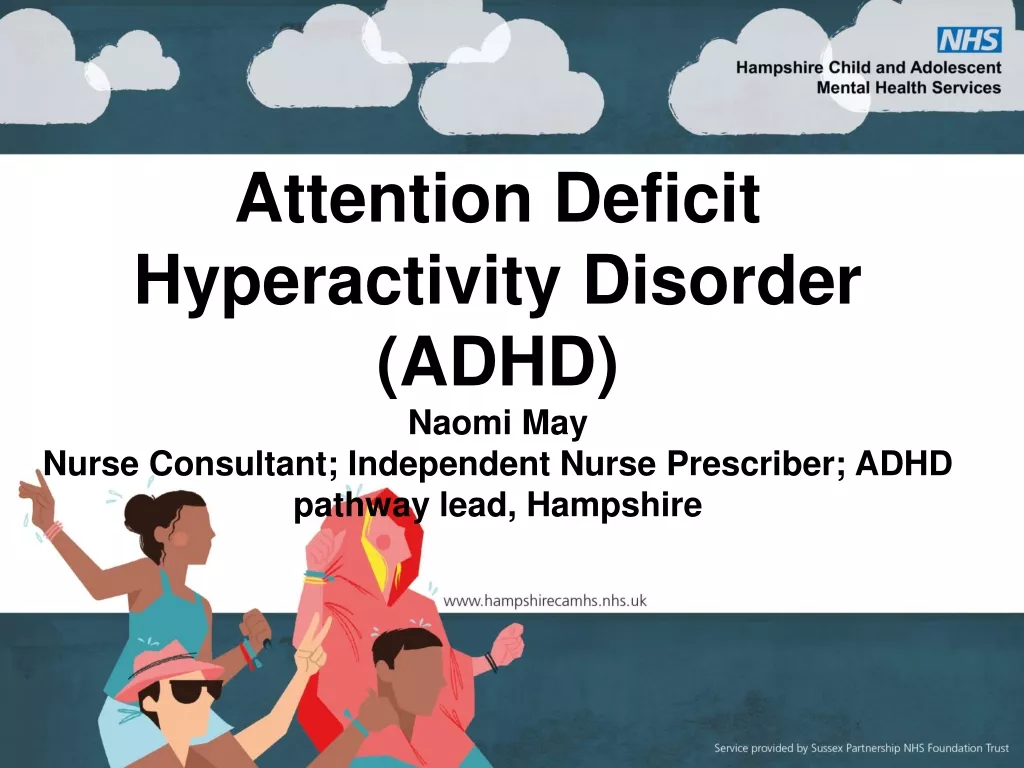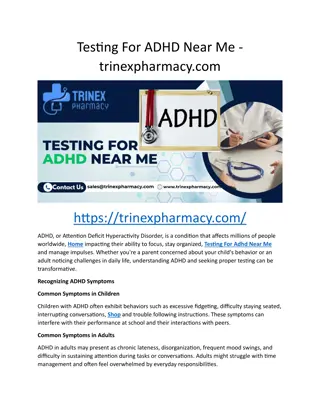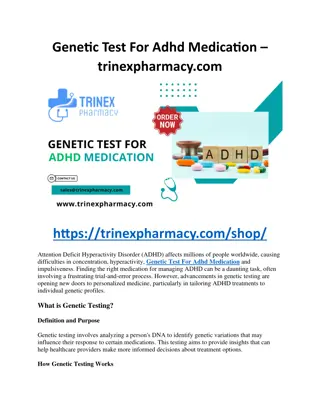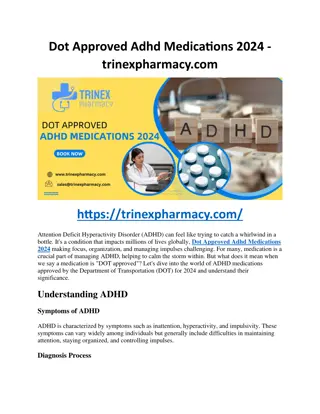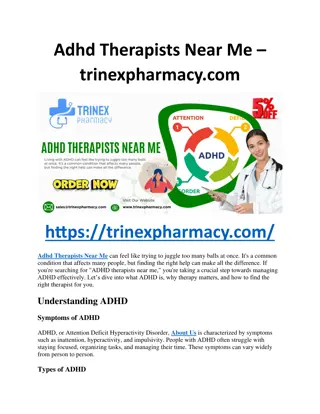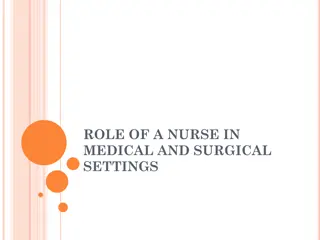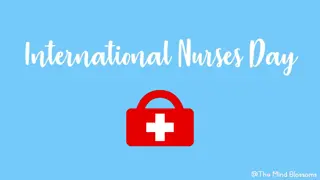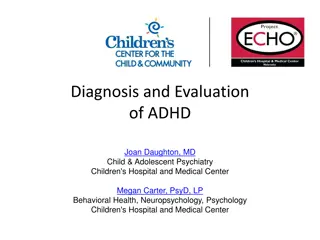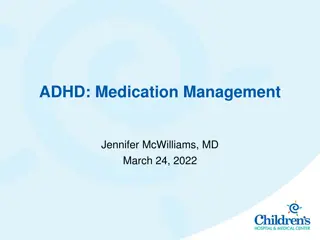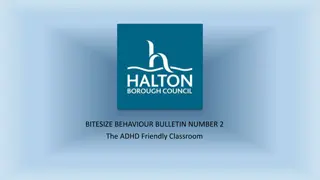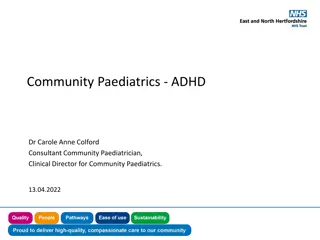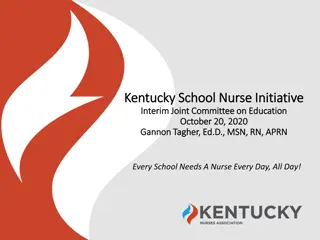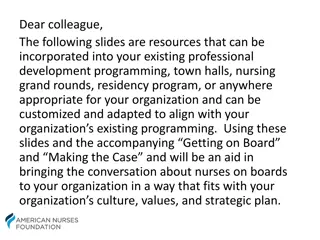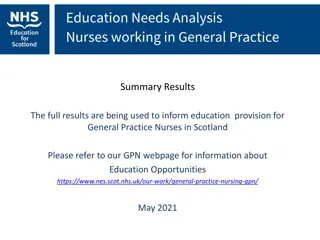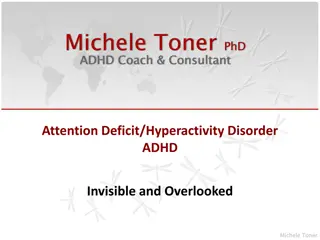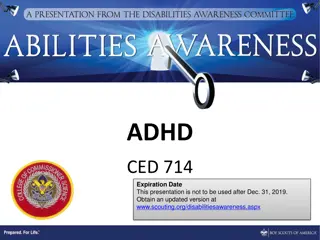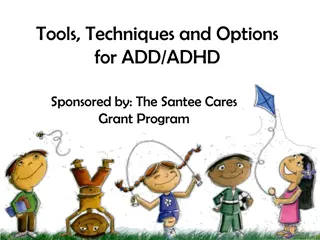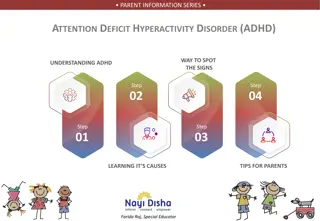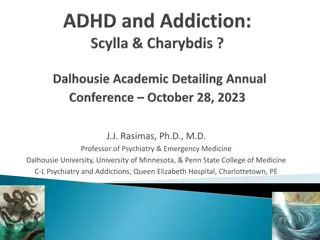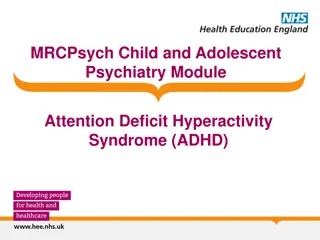Updates in ADHD: Diagnostic and Medical Considerations for School Nurses
Review clinical features, diagnostic criteria, and treatment options for Attention Deficit Hyperactivity Disorder (ADHD) presented by experts during a School Nurses Conference. Covering DSM-V criteria, prevalence of subtypes, assessment of inattentive and hyperactive symptoms, and medication management for ADHD across different age groups.
Uploaded on Jul 30, 2024 | 5 Views
Download Presentation

Please find below an Image/Link to download the presentation.
The content on the website is provided AS IS for your information and personal use only. It may not be sold, licensed, or shared on other websites without obtaining consent from the author.If you encounter any issues during the download, it is possible that the publisher has removed the file from their server.
You are allowed to download the files provided on this website for personal or commercial use, subject to the condition that they are used lawfully. All files are the property of their respective owners.
The content on the website is provided AS IS for your information and personal use only. It may not be sold, licensed, or shared on other websites without obtaining consent from the author.
E N D
Presentation Transcript
What is ADHD? Updates in ADHD for School Nurses: Diagnostic and Medical Considerations James Weedon, MD Developmental and Behavioral Pediatrician Division Director for Developmental Pediatrics Lindsay Wargelin, APN Pediatric Nurse Practitioner Developmental Pediatrics School Nurses Conference April 9, 2019
Objectives Review the clinical features and presentation of Attention Deficit Hyperactivity Disorder and evaluation process Understand diagnosis and treatment recommendations based on age group Discuss the use and management of medication in treating ADHD
What is ADHD? DSM-V criteria Symptoms of inattention or hyperactivity/impulsivity have persisted for at least six months and there is functional impairment in two or more settings. NEED input from teachers, other adults besides parents. ADHD Subtypes Hyperactive, Inattentive, Mixed
DSM-5 Criteria Inattentive Symptoms Inattention: Six or more symptoms of inattention for children up to age 16, or five or more for adolescents 17 and older and adults; symptoms of inattention have been present for at least 6 months, and they are inappropriate for developmental level: Often fails to give close attention to details or makes careless mistakes in schoolwork, at work, or with other activities. Often has trouble holding attention on tasks or play activities. Often does not seem to listen when spoken to directly. Often does not follow through on instructions and fails to finish schoolwork, chores, or duties in the workplace (e.g., loses focus, side-tracked). Often has trouble organizing tasks and activities. Often avoids, dislikes, or is reluctant to do tasks that require mental effort over a long period of time (such as schoolwork or homework). Often loses things necessary for tasks and activities (e.g. school materials, pencils, books, tools, wallets, keys, paperwork, eyeglasses, mobile telephones). Is often easily distracted Is often forgetful in daily activities.
DSM-5 Criteria Hyperactive Symptoms Hyperactivity and Impulsivity: Six or more symptoms of hyperactivity- impulsivity for children up to age 16, or five or more for adolescents 17 and older and adults; symptoms of hyperactivity-impulsivity have been present for at least 6 months to an extent that is disruptive and inappropriate for the person s developmental level: Often fidgets with or taps hands or feet, or squirms in seat. Often leaves seat in situations when remaining seated is expected. Often runs about or climbs in situations where it is not appropriate (adolescents or adults may be limited to feeling restless). Often unable to play or take part in leisure activities quietly. Is often "on the go" acting as if "driven by a motor". Often talks excessively. Often blurts out an answer before a question has been completed. Often has trouble waiting his/her turn. Often interrupts or intrudes on others (e.g., butts into conversations or games)
Why is ADHD a Problem? Prevalence of 8-10% of all school-age children 5.2 Million Children, 2 :1 -- Male : Female High incidence of co-morbid disorders Learning Disability, ODD, CD, Anxiety, Depression Left untreated School failure Difficulty with peer relationships Risk taking behaviors Difficult to achieve success
AAP Clinical Guidelines Published November 2011 in Pediatrics Result of a 2 year task force including members of: American Academy of Pediatrics American Academy of Child and Adolescent Psychiatry Child Neurology Society Society for Pediatric Psychology National Association of School Psychologists Society for Developmental and Behavioral Pediatrics American Academy of Family Physicians Children and Adults With Attention-Deficit/Hyperactivity Disorder (CHADD) Epidemiologist from the Centers for Disease Control and Prevention (CDC).
Key Action Statements Primary care clinician should initiate an evaluation for ADHD for any child 4 through 18 years of age who presents with academic or behavioral problems and symptoms of inattention, hyperactivity, or impulsivity. Previously 6 through 12 years of age. ADHD is difficult to diagnose accurately in the earlier years of life.
Key Action Statements Include assessment for other co-morbidities Emotional or behavioral Anxiety, depressive, oppositional defiant, and conduct disorders Developmental Learning and language disorders or other Neurodevelopmental disorders Other tics, sleep apnea
Diagnostic Considerations Anxiety or depression can present as hyperactivity or inattention in children Children with developmental delay should be assessed according to their developmental expectations Children with ADHD-combined or primarily hyperactive are identified earlier than with inattentive subtype and boys tend to be more hyperactive than girls. Most common presenting symptom in preschool is hyperactivity and impulsive control
Treatment of ADHD Three-pronged approach 1. Behavioral modification 2. Educational support 3. Use of medication to supplement
Evidence for Treatment by Age Age 4-5 (Preschool-aged) First line: Evidence-based parent and/or teacher- administered behavior therapy Quality of evidence A / Strong recommendation If behavioral interventions do not provide significant improvement and symptoms are moderate-severe, trial of stimulant medication with weighing harm of early medication with delay of diagnosis and treatment Quality of evidence B / Strong recommendation
Evidence for Treatment by Age Age 6-11 (Elementary school-aged) Evidence stronger for ADHD medication Quality of evidence A / Strong recommendation And/or Parent/teacher behavior therapy Quality of evidence B / Strong recommendation Preferably both with educational supports
Evidence for Treatment by Age Ages 12-18 (Adolescents) ADHD medication Quality of evidence A / Strong recommendation Behavior therapy Quality of evidence C / Recommendation Preferably both with educational supports
Educational Accommodations and Supports
Educational Supports Classroom environment Special education vs. mainstream classroom Accommodations Educational strategies Individualized Education Program IEP 504 plan
Examples of School Accommodations Physical Seating Organization of materials Removal of distractions including during testing Instructional accommodations Repeat and simplify directions Check in for understanding Provide examples and written instructions Behavioral accommodations Positive reinforcement Special jobs or leadership duties Open communication with parents
Medication Considerations Finding the right medication (stimulants vs non-stimulants) Starting at a low dose and increase slowly Monitor for side effects versus benefit Use Vanderbilt questionnaire as a baseline to monitor response to treatment
ADHD Medications Stimulants 1. Methylphenidates 2. Amphetamines Nonstimulants Atomoxetine (Strattera) Alpha-2-adrenergic agonists Antidepressants Tricyclics and dopamine reuptake inhibitors
Stimulant Pharmacokinetics Weight dependent dosing in children is not well established. In general, start at a low dose and increase slowly. Onset of action 45 min to 1 hour Duration Immediate release 3-5 hours Extended release 8-12 hours Be wary of peaks and valleys
Side Effects of Stimulants Appetite suppression Sleep disturbance Weight loss Transient symptoms: Headache, stomachache Stop taking immediately if: Acute marked changes in behavior or mood Symptoms of hallucination, psychosis, or mania
Other Concerns Stimulants as gateway to drug abuse? NO! Untreated ADHD has increased risk of substance abuse. Treated ADHD risk of substance abuse is near population levels.
Atomoxetine (Strattera) Selective norepinephrine reuptake inhibitor Not a controlled substance Oral capsule do not open and sprinkle Starting dose of 0.5 mg/kg/day, titrate to 1.2 mg/kg/day. Max of 1.4 mg/kg/day Daily dosing or BID Must be given every day
Side Effects of Strattera Less common Abdominal pain, nausea, vomiting Decreased appetite Headache Somnolence
Alpha-2-Adrenergic Agonists Clonidine (Catapres) Initial dose 0.1mg at bedtime, titrate by 0.1mg weekly, maximum 0.4mg/day, up to QID Extended-release: Kapvay Guanfacine (Tenex) Initial dose 0.5-1mg/day at bedtime, titrate by 0.5- 1mg weekly, maximum 4mg/day, up to QID dosing Extended-release: Intuniv
Alpha-2-Adrenergic Agonists Can be used as monotherapy or adjunct to stimulant medication Requires 1-2 weeks for initial response Must taper off slowly to prevent rebound hypertension
Side Effects Sedation Bradycardia Headache Hypotension May be useful in children who are over- aroused, highly active, and aggressive Improvement in tics
How to Track Efficacy Vanderbilt Rating Scales Parent and teacher School reports Academic progress Behavior reports
Additional treatment strategies Social skills groups Occupational therapy ADHD coach Parent support groups
Resources Taking Charge of ADHD by Russell Barkley, PhD SOS Help for Parents by Lynn Clark, PhD Smart But Scattered by Dawson and Guare Siblings Without Rivalry by Faber and Mazlish CHADD chadd.org Family Resource Center on Disability www.parentsmedguide.org


